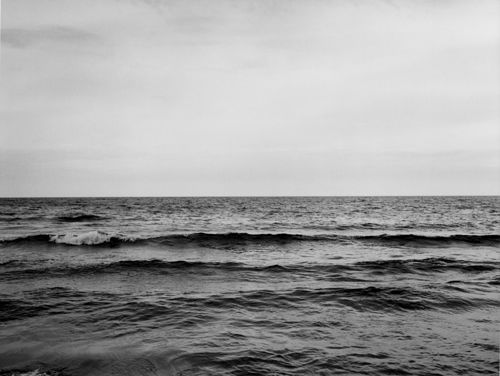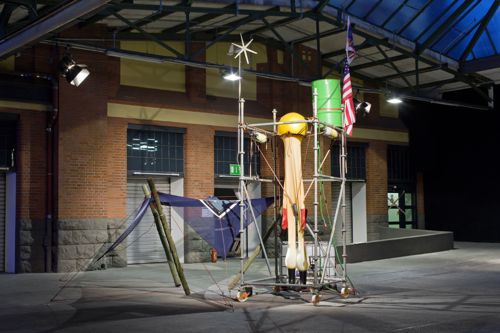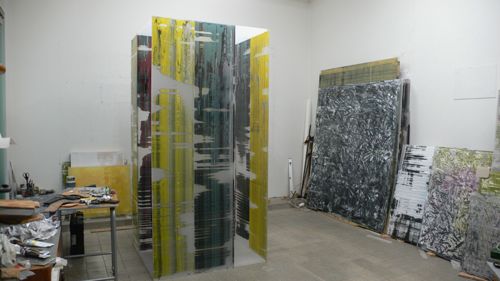
Tag: Galerie Nordenhake
Michael Schmidt

Galerie Nordenhake is very pleased to announce Michael Schmidt’s upcoming retrospective exhibition at Haus der Kunst, Munich, and the artist’s participation in the 2010 Berlin Biennale.
Since 1965, Schmidt has created a distinctive body of work, including such seminal series as “Waffenruhe” (Ceasefire), “EIN-HEIT” (U-NI-TY), “Berlin nach 1945” (Berlin After 1945), “Frauen,” (Women), “Stadtbilder” (Berlin – Urban Images), and “Irgendwo” (Somewhere). The exhibition at Haus der Kunst presents Schmidt’s major photographic works from the past four decades, along with previously unpublished photographs from the 1980s, newly edited series, and recent works, including a series of seascapes. For the Haus der Kunst presentation, Schmidt will devise idiosyncratic installations specifically for the venue’s architecture. An artist’s book of the series “89-90,” which previously only existed as artist proofs, will accompany the exhibtion.
Schmidt’s series “Frauen” has been featured as the first artistic contribution to the 6th Berlin Biennale. The series, showing singular portraits of clothed and nude women, is currently visible in public posters throughout Berlin and will remain on view for the duration of the Biennale.
Marjetica Potrc

Galerie Nordenhake Stockholm presents an exhibition by the Slovenian artist Marjetica Potrč. Through her multi-disciplinary practice that merges art, architecture and social science Potrč’s work negotiates the challenges of global developments in the areas of town planning and architecture. Her work emphasizes self-reliance and individual empowerment, problem-solving tools and strategies for the future and testifies to the failures of some of the grand principles of Modernism. In the exhibition she shows a case-study structure and two series of works on paper.
Burning Man: Tensegrity Structure and Waterboy, is an architectural structure from the Burning Man Festival in the Black Rock Desert in Nevada. The festival is described as an experiment in community, radical self-expression, and radical self-reliance. The tensegrity structure is based on a design first developed by Buckminster Fuller and Kenneth Snelson in which its stability is result of the principal of the balance of push and pull. Here the shelter is upgraded with self-sustainable technologies such as a solar canopy and a wind turbine, which power the water pump that serves the Waterboy, a cooling bath respite in the desert heat, designed by Marque Cornblatt for the Burning Man Festival. By combining strategies for both leisure and subsistence, participants in Burning Man practice survival strategies through play.
The Homo Ludens (Latin for “Man the Player”) and Venice series of drawings are a result of recent on-site research. Both series address the problems and challenges of the tremendous changes to our living conditions due to global warming and the planet’s changing geology but also represent a celebration of self-sustainable practices and community building.
Homo Ludens explores the hypothesis that the Black Rock Desert will re-fill with water and become a lake again. Changing water levels require new architectures – perhaps of the type currently designed in a playful manner at the Burning Man Festival. In Venice the rising water level has a fundamental impact on the local communities and their living conditions. Both architectures proposed are self-sustainable, temporary and flexible catering to a more nomadic lifestyle.
Marjetica Potrc is an artist and architect based in Ljubljana, Slovenia. She is best known for her on-site projects using participatory design, her drawing series, and her architectural case studies. Her work has been featured in exhibitions throughout Europe and the Americas, including the São Paulo Biennial in Brazil (1996 and 2006) and the Venice Biennial (1993, 2003, and 2009); and she has had solo shows at the Guggenheim Museum in New York (2001); Max Protetch Gallery in New York (2002 and 2005); Galerie Nordenhake (2003, 2004 and 2007). Her many on-site installations include Dry Toilet (Caracas, 2003) and The Cook, the Farmer, His Wife and Their Neighbour (Stedelijk goes West, Amsterdam, 2009). She has taught at several well-known institutions in Europe and North America, including the MIT (2005) and IUAV Universita luav di Venezia (2008, 2010), and has published a number of essays on contemporary urban architecture. She is the recipient of numerous grants and awards, most notably the Hugo Boss Prize (2000) and the Vera List Center for Arts and Politics Fellowship at The New School in New York (2007). She is currently engaged in the on-site project Between the Waters: The Emscher Community Garden’ for “Emscher Kunst”, Essen, the European Cultural Capital, 2010.
Håkan Rehnberg //Counter-moment

For the last 30 years Håkan Rehnberg has methodically explored space and flatness in his painting. His choice of plexi-glass is an acknowledgement of the physical properties of the object on which he paints: plexi is a screen, an object and a frontal plane. For Rehnberg the decisive moment of painting, full of contradictory impulses, intuition and intention, is one of exposure and vulnerability.
With broad strokes, defined by a plasterer’s palate, Rehnberg draws out planes of colour, carving out spaces. In a process of layers he both reveals and conceals, leading to what can be seen as a flattened architecture – an inaccessible room.
The inaccessible room is both a physical place and a conceptual site. In his sculptures the room becomes almost inhabitable, sometimes inviting shelter and yet providing none. Often a closed space with only visual access, the sculpture recalls an eddy in a river – a recurring thought.
In this exhibition Rehnberg continues to explore these themes in new directions. Two works suggest a forensic archaeology – a scraping away to the white “bone” under the surface. Another painting reveals a frenetic scratching in a swarm of gestures.
The form of a beehive occurs repeatedly in the new works and combines the concept of the inaccessible room with the elements of revealing and concealing. The yellow, scented, beeswax is both painterly and sculptural.
Håkan Rehnberg will represent Sweden at the Sydney Biennale in May this year. He recently received great attention for his contribution to Åtta Kommentar in the Caspar David Friedrich exhibition at National Museet. He has exhibited widely both in Sweden and internationally, including Charlottenborg Kunsthal, Copenhagen, Studio A, Otterndorf, Museum gegenstandsfreier Kunst (Germany), Sønderjyllands Kunstmuseum, (Denmark), Reykavik Art Museum (Iceland), Helsinki City Art Museum (Finland), Centre Culturel Suédois (France). Venues in Sweden include Moderna Museet, Malmö Konstmuseum, Millesgården, Eskilstuna Konsthall, Rooseum, Wanås slottspark, and Liljevalchs Konsthall. Håkan Rehnberg was born 1953 in Göteborg. He lives and works in Stockholm. This is his fifth exhibition at Galerie Nordenhake.